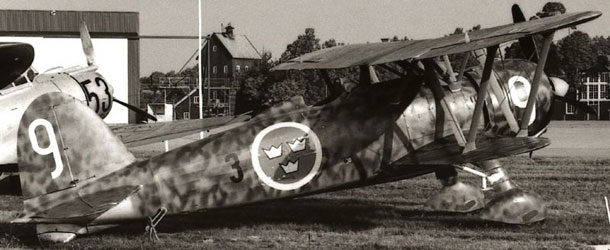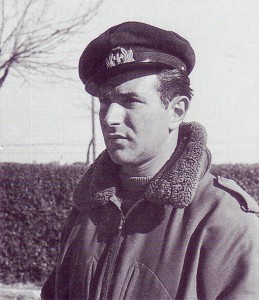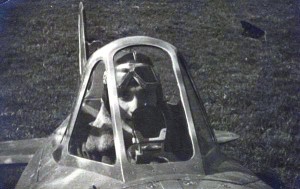In our previous article, we presented the Fiat CR.42 Falco aircraft. Now let’s learn something more about the pilots of the three versions included in the WW2 Wings of Glory Airplane Packs: the Italians Luigi Gorrini and Vito Rinaldi (Regia Aeronautica), and the German Feldwebel Hors Gressler (Lutwaffe).
Luigi Gorrini
Born in July 1917 in Piacenza, Italy, Luigi Gorrini joined the Regia Aeronautica in 1937 and was credited with 19 enemy planes shot down - some sources count 24 wins - and nine damaged. He was awarded with a "Medaglia d'Oro al Valor Militare" (Gold Medal of Military Valor) and two bronze medals, and with the German Iron Cross of 1st and 2nd Class. He also served in the Aeronautica Nazionale Repubblicana.
His first flight with a CR.42 was in November 1939, as a sergeant pilot of the 85a Squadriglia, 18o Gruppo, 3o Stormo – the unit he served with until 1943. He took part in the short French campaign in 1940 and then, during the operations in the Battle of Britain, he fought in the big combat on November, 11th over Harwich.
His unit returned to Italy in January 1941 and was immediately sent to Africa, where Gorrini claimed his first victory: In Libya,he shot down one of the first Beaufighters to appear in the Mediterranean area on 16 April 1941. He returned to Italy on March 9th, 1943, when he flew a CR.42 for the last time. He described the fighter as a tough aircraft and good up till 5000-6000 meters, but slow.
In Italy, he served the 85a Squadriglia, re-equipped with the Macchi MC.205 Veltro and assigned to the defense of Rome. He joined the Aeronautica Nazionale Repubblicana (ANR) on December 23th 1943, and was assigned to 1a Squadriglia. Gorrini was the top scoring C.205 pilot, shooting down 14 enemy airplanes and damaging six more.
After the end of the war, Gorrini joined the rebuilt Italian Air Force and served with it until 1979, when he retired. He lives at Alseno, in Piacenza, being the highest ranking Italian ace still alive, and the only surviving fighter pilot awarded the "Medaglia d'Oro al Valor Militare".
Vito Rinaldi
Born at Cerignola (Foggia, Italy) in January 1917, Vito Rinaldi was admitted at the flight school of Tassignano, in Lucca, in September 1937, where he got a civil license in February 1938, and was qualified as a military pilot in September that year, being assigned to the 2o Stormo Caccia at Benghazi (Cyrenaica), equipped with the Fiat CR.42 Falco.
Rinaldi is not mentioned in the official lists of Italian aces, but the book “Gli Assi Italiani della Seconda Guerra Mondiale” (“Italian Aces of WW2”), written by the researchers Giovanni Massimello and Giorgio Apostolo in 2000, mentions that this pilot’s logbook had been recently discovered indicating him as a possible ace. The logbook reports that Rinaldi claimed 9 kills and 9 shared victories, and its pages are signed by his various commanding officers thus giving some credibility to his claims.
In the official registers, Rinaldi received a silver medal for a mission over Tripoli on December 7th, 1940, flying the Fiat Cr.42 Falco represented in the WW2 Wings of Glory Airplane Pack. He was serving in the alarm service for the Tripoli defense, when a raid of huge enemy air forces against his airport started at the sunset.
Even if without previous night-flying training on fighters, he took off with his CR.42, giving up to wear his parachute to not lose precious time. He attacked an enemy aircraft forcing him to drop his bombs recklessly, and, under the raging fire of enemy weapons that hit his aircraft in several parts, he stood firm in the attack. He flew away from the enemy only when he saw the airplane losing altitude above the sea, and starting to take fire. Then, he turned to attack a second enemy plane, until his ammo was finished, and landed safely under the moonlight.
Rinaldi was transferred to a night fighter group in Sicily, equipped with CR.42s - three of them modified as night fighters. He performed several strafing and night bombing missions against Malta airfields, and an action granted him the "Medaglia di Bronzo al Valore Militare" in September 1941. On October 21st, 1942 he was decorated with the "Deutsche Verdienstmedaillie Mit Schwerten" by the Luftwaffe.
Rinaldi retired in 1944. He died on March 11th 1992, after flying for the last time just the day before.
Horst Gressler
In October 1943, the Lutwaffe withdrew ten experienced pilots of NSGr.3 from the northern sector of the Eastern Front to form the NSGr. 9. The Nachtschlachtgruppe 9, also called “Ghost Bombers”, was the Luftwaffe’s unit equipped with the CR.42’s version built by Fiat for the Luftwaffe. The unit was based in Italy for night harassment missions over the Allied lines, including attacs on the the Anzio beachhead. The Feldwebel (Master Sergeant) Horst Gressler was one of the German pilots that flew the CR.42 in that group.
In June 1944, after having attacked Allied gun positions and columns in the Artena-Giulianello-Cori area, south-east of Rome, Feldwebel Horst Greßler was chased on the return flight by a Beaufighter at around 1400 m of altitude. Gressler and his aircraft were hit by 40 cannon shells and 120 machine-gun rounds. He managed to get away, regaining control only 200 meters above the ground. Despite his serious woudns, Gressler was able to bring back the aircraft to his airfield, where it was destroyed by fire after the emergency landing. He was hospitalized but returned to operations with NSGr.9 a few months later.
Information sources: Håkans aviation page – Gorrini, Rinaldi, Lutwaffe CR.42; Asisbiz, Stormo Magazine; Wikipedia.











Follow Us on